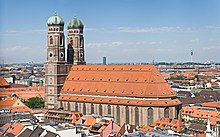Onion dome

An onion dome is a tower with an onion hood or an onion helmet , e.g. B. a church tower whose top is worked in the shape of an onion . The lower part of the top is bulbous and tapers upwards, comparable to the steeples of Moscow's St. Basil's Cathedral . In addition to round shapes, towers with angular domes are also known as onion dome.
history
The oldest bellied onion hoods in the Christian Orthodox cultural area can probably be found in the Assumption Cathedral (1475–1479) in Moscow .
In 1486, hood architecture in Germany received significant inspiration from Bernhard von Breidenbach's travelogue, published and illustrated in German, of a pilgrimage to the Holy Land .
The relatively flat onion dome of the Munich Frauenkirche was designed around 1525 based on a design by Jörg von Halspach , which is said to have been inspired by the Byzantine-influenced Madonna dell'Orto church in Venice . The later Bavarian hoods were steeper, more constricted and therefore more onion-shaped. There are various theories about the origin of this form of onion domes. A model could have been the Ottoman helmet , which became known in Europe after the Turkish invasion in 1529. But Italian influences, which can be traced back to Byzantine architecture, could also have been reflected in it.
The first such onion dome in southern Germany was built by Hans Holl (1512–1594) in 1576 at the church of the St. Maria Stern monastery in Augsburg. His son Elias Holl later planned the two onion domes for the Augsburg City Hall.
After the damage caused by the Thirty Years War , numerous churches in southern Germany were rebuilt with onion domes. The onion dome became a typical form element of the southern German baroque .

In 1561 St. Basil's Cathedral was completed, which is more like the Bavarian domes than the domes in Constantinople . The advantage of the steep onion shape is that snow is more easily detached from the roof.
execution
The roof stalls of onion domes require special skills from the carpenters because of their complex shape . Onion domes are covered with sheet copper or slate.
The traditional construction of an onion dome consists of several layers of hammered copper sheet ; Old onion domes can therefore usually be recognized by the green color (cf. copper patina , copper hydroxide, copper carbonate ) of their roof hood .
distribution
Onion domes are widespread in the German-speaking countries mainly in the southern federal states of Germany , in Austria and in South Tyrol, which belongs to Italy, where Catholicism predominates. They are typical features of baroque churches. Onion domes in Orthodox church buildings in countries of the former USSR and Bulgaria are known worldwide . Orthodox churches with onion domes can often be found in international health resorts and bathing resorts where Russian aristocrats used to go to health resorts or "summer retreats", for example:
- Russian Chapel (Darmstadt)
- Bad Ems Church of St. Alexandra
- Russian Chapel (Bad Homburg)
- Russian Church (Baden-Baden)
- Church of Sergius of Radonezh (Bad Kissingen)
- Russian Orthodox Church (Wiesbaden) on the Neroberg
- Nice or
- Karlovy Vary ( Carlsbad ) St. Peter and Paul.
Since the middle of the 19th century, thousands of Russians have spent the summer months in German and Western European health resorts. First of all, Russian aristocrats and wealthy middle-class families came with their relatives and servants. Due to the expansion of the European railway network between 1860 and 1880, the number of spa guests skyrocketed. For example, since the turn of the century, between 5000 and 8000 spa guests from the Russian Empire have come to Bad Ems and Bad Kissingen every year. Since they usually stayed for several weeks, Russian Orthodox chapels or churches were built in many of these places.

The onion dome has its very own conception and distribution in the Bergisches Land , where it developed independently of the southern German onion domes into a main feature of the Protestant church buildings in the Bergisch Baroque style. A highlight of the Bergische onion domes are the always present lanterns , which can be seen as a special distinguishing feature from the southern German style. The following churches, among others, have onion domes in the Bergisch Baroque style:
- Old church Wupperfeld
- Reformed Church of Cronenberg , it is one of the most beautiful churches in the Bergisches Land due to its onion dome
- Evangelical town church (Remscheid)
- Evangelical town church (Lennep)
- Evangelical town church Lüttringhausen
- Evangelical Church in Niedersprockhövel
- Evangelical town church Wermelskirchen
particularities


- The Martinsturm with its four-sided onion helmet and lantern, the symbol of Bregenz , is considered to be the tower with the largest onion in Central Europe.
- Round church St. Johann Baptist and Holy Cross in Westerndorf with round onion dome (1691)
- Baroque parish church of Mary Help of the Star in Železná Ruda with a twelve-sided onion dome and onion dome
- The dome of the Cathedral of Christ the Savior in Moscow is even larger .
- An example of a Barockkirche with an onion tower is the evangelische Johanniskirche in Frankfurt district Bornheim having a square tower hood.
The onion dome became a "trademark" of Friedensreich Hundertwasser .
- The Hundertwasser House in Vienna has an onion dome.
- The Hundertwasser House Magdeburg has stylized onion domes.
Onion dome in the media
“The Onion Dome” is also the title of a television documentary (ORF, 3sat) by Christian Wallner about the Church and State in the Third Reich, which was broadcast for the first time in 1983 .
Individual evidence
- ↑ http://www.augsburger-gedenkenage.de
- ↑ Christiana Schilig: How did the Bavarian onion domes come about? Monumente, 5 (2015), p. 21.
- ↑ Russian Church Bad Ems ( Memento from December 24, 2010 in the Internet Archive )
- ↑ faz.net



